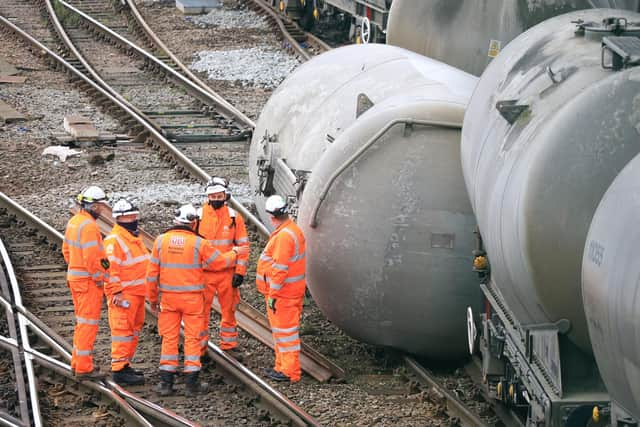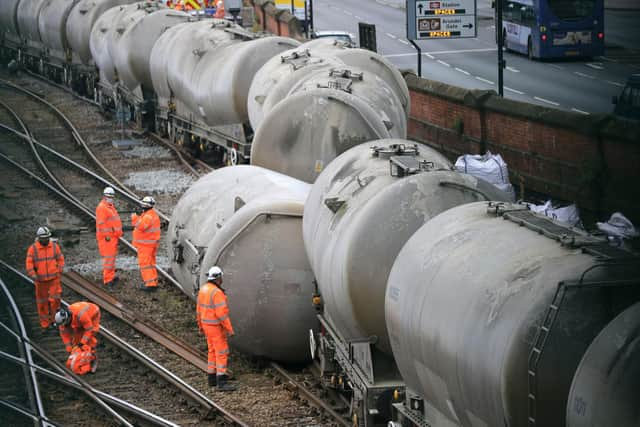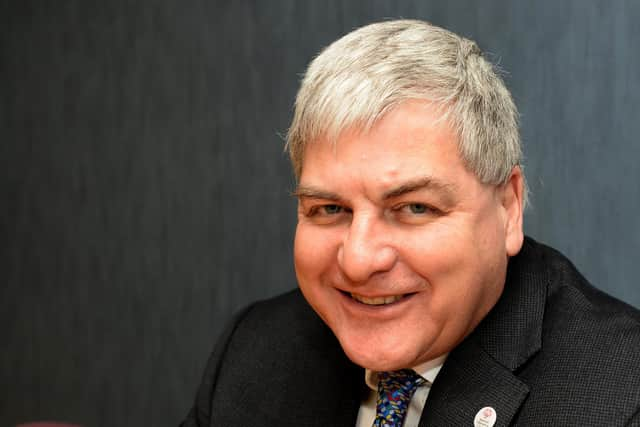Growing calls for rail investment in Sheffield after decades in the sidings
and live on Freeview channel 276
When 16 carriages of a cement train left the track at Midland Station on November 11 it caused days of disruption across the country.
The incident shone a light on rickety infrastructure and 40 years of decline, including delayed upgrades, cancelled services and proposed schemes failing to arrive at all, according to David Smith, a former principal research officer at Sheffield City Council.
Advertisement
Hide AdAdvertisement
Hide AdToday, Sheffield is the largest city and busiest station not on the electrified network, its position on the HS2 route is uncertain and the main benefits of Northern Powerhouse Rail are further away still.


That is despite it being at the centre of the country, with lines running east-west (Liverpool, Manchester, Hull), north-east to south-west, London to the North, and out to East Anglia. It also has the advantage of one station, making changing trains easier than at cities with two, like Manchester.
Sheffield stands to benefit from more projects than at any time for years and, although three years late, coming down the track by 2023 is an upgrade to the Hope Valley Line which will see fast trains to Manchester increase from two to three an hour.
The case for the electrification of the Midland Mainline to Sheffield is back up the agenda - after the city was dumped from plans in 2017 - due to climate change, falling installation costs and HS2.
Advertisement
Hide AdAdvertisement
Hide AdNorthern leaders recently reached a agreement about how Northern Powerhouse Rail should look and are campaigning hard to see the £39bn scheme approved.


More locally, feasibility studies are underway for new stations at Waverley, Barnsley and Rotherham as well as tram-trains from Rotherham to Doncaster and the airport.
But the city has a lot of catching up to do.
It is exactly 40 years since Sir Peter Parker, chairman of British Rail, proposed a 15-year programme of electrification, which would have included the Midland Mainline from London to Sheffield and beyond. Today, it has reached Kettering and is set to extend to Market Harborough by 2023 - still a long way from Sheffield.
Mr Smith said other downgrades include the removal of two of the four tracks between Sheffield and the junction at Dore. A fast train to Leeds, which took 35 minutes, closed in the 1980s. And a 125mph service on the East Coast Mainline to Doncaster was launched in 1976, six years before Sheffield.
Advertisement
Hide AdAdvertisement
Hide Ad

He added: “I'm not surprised a derailment happened because I doubt whether any significant investment in track and signalling has taken place at Sheffield station and its approaches for nearly 50 years.
“Compared to Leeds and Manchester the situation is lamentable. They have regularly had upgrades and improvements costing hundreds of millions of pounds as well as modern electric trains. Moreover, the Northern Powerhouse proposals will further concentrate investment on these cities.
“I wrote a very comprehensive report on behalf of Sheffield Council which explained why it would make sense to give Midland Mainline a high priority. Sadly, the Conservative governments of the 1980s had limited views as to the role of the railways and subsequent Labour governments proved equally disinterested.
“Today, the case is irrefutable: it’s the busiest station not on the electrified network, the decarbonisation agenda and pollution at the station help make the case and Sheffield has largely been side-lined by the HS2 proposals as they now stand. So, more pragmatic, lower cost improvements are the way forward, with higher speeds and junction improvements on routes such as Sheffield to Leeds, via Barnsley, along with modern faster trains.”
Advertisement
Hide AdAdvertisement
Hide Ad

Peter Kennan, chair of the transport forum at Sheffield Chamber, said the city needed “much more lobbying from MPs so we are top of the agenda.”
Most urgent was a final decision on the eastern leg of HS2, due in February.
There are fears that a ‘phased completion’ plan could mean construction in Yorkshire would not begin until 2040, prompting concerns it may never happen.
He added: “We are fighting our corner with partners in West Yorkshire and the East Midlands. And all the new Tory MPs in ‘Red Wall’ areas will be lobbying like mad.
Advertisement
Hide AdAdvertisement
Hide AdLeeds has three times as many passengers as Sheffield - 30m compared to 10m a year - and would always get more investment.
He added: “The potential for rail schemes benefiting Sheffield has never been higher. People need to know how much effort is going into delivering HS2 and Northern Powerhouse Rail.”


Sheffield Central MP Paul Blomfield agreed that electrification of the Midland Mainline should be top priority - followed by HS2 and NPR.
He added: “We need to rebalance rail investment between north and south. Providing a proper rail service with journey times of 30 minutes from Sheffield to Leeds and Manchester, would transform the passenger experience and create an economic hub which could compete with London for investment.
Advertisement
Hide AdAdvertisement
Hide Ad“If we’re to hit our targets for reducing carbon emissions, we’ve also got to shift passengers and freight from roads to rail. That means a substantial increase in rail capacity and HS2 is an important part of that.”
Sheffield South East MP Clive Betts said the city was ‘forgotten about on the national stage’ and it was important to keep the pressure on.
He added: “I think it will be difficult to stop the eastern leg of HS2. It would compromise the cost-benefit of the whole scheme.”
A Department for Transport spokeswoman said: “Northern Powerhouse Rail is a key part of the Government’s agenda to level-up the North and, once built, it will transform connectivity across the region and provide faster more frequent services for passengers.
Advertisement
Hide AdAdvertisement
Hide Ad“Our upcoming Integrated Rail Plan will also outline how projects, including HS2 and Northern Powerhouse Rail, can work together to deliver the reliable train services that passengers need and deserve, as quickly as possible.”